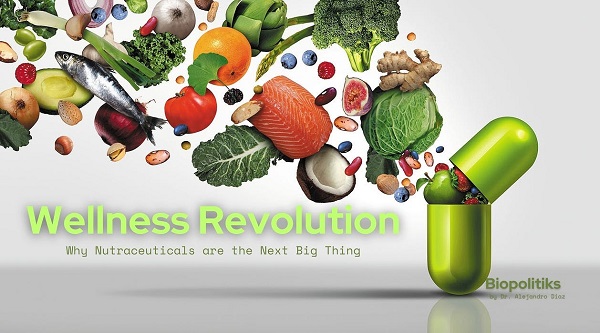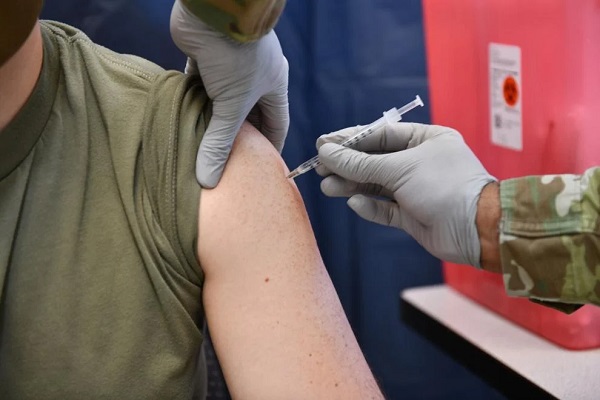Health
Wellness Revolution

|
|
From Courageous Discourse
Why Nutraceuticals are the Next Big Thing
The New Health Conscious
The revival of health consciousness that has taken place in this decade has changed the way the general public views healthcare—forever. The COVID Operation put health back into the conversation. This elevation in the collective health consciousness has led to a Wellness Revolution, worldwide.
Patients now understand the reality of the state of healthcare systems. The fact is that we are a highly medicated and highly vaccinated society, and the truth is that as the use of these products has increased, so has disease prevalence.
If we take more vaccines and more medications than ever before as a society, shouldn’t we be healthier than ever? Unfortunately, this isn’t the case. The global population is sick and only getting sicker; the toxic injectable products, gene therapy, so-called “COVID Vaccines” made sure that people become permanent clients of the sick-care industrial complex.
A stellar example of this phenomenon is the United States. The United States makes up around 4% of the world’s population, yet it represents around 64 to 78 percent of global pharmaceutical profits. This should mean that Americans are the healthiest in the world by far, right? Unfortunately, no. The United States leads the world in chronic disease prevalence and has a significantly lower life expectancy than most other developed nations.
The current system is fraudulent. People are taking notice of this fraud. In protest, they are looking for alternatives to traditional medicines for disease care. One of the emerging therapeutics in this realm is nutraceuticals.
Nutraceuticals are foods or elements of food obtained from plant or animal origin with significant medical or health benefits utilized to prevent or cure diseases. The medicinal use of food or food elements derives from the beginning of modern medical understanding. Hippocrates is famous for his remarks on this issue. He states, “Let food be thy medicine and medicine be thy food.”
As an allopath (Pediatric Allergist/Immunologist), I increasingly shift towards this alternative line of thinking. I am not saying that all medications are bad, but I think we have to be far more selective in the way we use them.
Recently the term “nutraceuticals” has regained relevance. Once brushed off by the medical community as fringe “pseudoscience” with no demonstrated clinical benefits, is now being lauded at the highest levels of healthcare policy. In a controversial tweet, just before the U.S. Presidential Election, Robert F. Kennedy Jr. shared some details of his plans for public health in the United States.
I have repeatedly mentioned the significance of Robert F. Kennedy Jr.’s appointment to lead the Department of Health and Human Services. His appointment assures that the official narratives on alternative approaches will change from a tone of “aggressive suppression” as RFK describes it, to one of medical freedom. This will surely accelerate the effects of the wellness revolution.
The Wellness Revolution
This movement represents a change in the public’s attitudes toward their health. This has materialized in several different ways. First, it is in the products that patients choose to consume. Pharma, for example, has taken advantage of this wellness attitude shift by introducing products such as GLP-1s, statins, and other drugs to remediate the effects of the chronic disease epidemic that they caused. Additionally, it’s very common to see these drugs cause side effects, forcing patients to take yet another pill to “alleviate” the adverse effects, resulting in a never-ending vicious cycle.
It all boils down to a social movement that emphasizes disease prevention and longevity. The medical device industry has seen an explosion of growth for these reasons. Particularly wearable medical devices such as health trackers. These functional health trends are transforming patient care.
Probably the most significant way that this wellness revolution is materializing is in terms of diet and nutrition. The dietary supplement and nutrition industry has seen an explosion in growth over the last couple of decades, and with growing demand due to distrust and disillusion with traditional pharma and medical systems, this growth is set to continue. But even in nutrition, we have to regulate how they treat the source with pesticides and fertilizers, etc.
The term “nutraceuticals” is relatively new but has gained rapid relevance in alternative medical spaces. Although the term encompasses a broad umbrella of elements, essentially it refers to natural food products or components found in food that can be utilized for medicinal purposes. This can include components such as prebiotics, probiotics, vitamins, fibers, etc.
This functional approach to health is what will take the medical profession into the future. At the end of the day, these methods are in the best interest of the patient.
The microbiome is another example. A new world of information that explains how bifidobacteria interact and regulate many bodily functions. Dr. Sabine Hazan, an expert in the field, has talked extensively about this issue in her book “Let’s Talk SH!T”, a must-read.
Functional foods and nutraceuticals will be the base of treatment in the foreseeable future. These compounds provide health benefits beyond basic nutrition and contain bioactive compounds that can affect the body in various ways. for example, reduce cholesterol levels and inflammation, including examples such as fermented foods like miso, kimchi, flax seeds, salmon, omega-3 fatty acids, and walnuts. While compounds such as probiotics promote gut microbiota balance, which is crucial for immunity and digestion.
The immense majority of diseases have one common denominator: Inflammation. Considering how functional foods and nutraceuticals have inflammation-reducing benefits, these products can have an extensive range of applications.
I would like to provide a couple of examples of bioactive compounds that have medicinal benefits. Turmeric and Curcumin, for example, have anti-inflammatory, and antioxidant benefits and may also contribute to remediating the effects of heart disease, Alzheimer’s disease, and depression. Some even cite turmeric’s potential to inhibit cancer progression.
What the shift to these products also represents is an emphasis on prevention. Increased clinical use of these types of natural products will promote a culture of disease prevention rather than disease management.
Robert F. Kennedy Jr. was asked in an interview recently with CNBC’s Jim Cramer about his thoughts on GLP-1s. RFK Jr. responded by saying “The first line of response should be lifestyle. It should be eating well—making sure you don’t get obese…”
This represents a fundamental shift in the line of thinking in those leading public health policy. I have never heard anyone in government speak that way.
The ideological change that is set to take place as the new administration takes power will surely flow downstream to medical standards of care, further exacerbating the growth in the market of natural remedies, including nutraceuticals.
I fully support this change. For too long, patients and even doctors have been attacked on all fronts, forcing them to cave to the status quo or face excommunication from the medical religion. If we are sincere, medicine is a religion. Dr. Robert Mendelsohn touches on this topic in his book “Confessions of a Medical Heretic”.
Physicians from all medical orthodoxies, whether they be allopathic, homeopathic, osteopathic, or naturopathic, should unite in consensus about the healing effects of these compounds and their applications in treating and managing disease.
A shift away from over-medication is necessary to reverse the effects of the chronic disease epidemic and the long-term promotion of optimal health.
Nutraceuticals: Bridging the Gap between Nutrition and Medicine. This emerging field has become a cornerstone in the shift towards preventive healthcare, where the focus is not only on treating illness but also on sustaining optimal health. A new awareness in the field of medicine is on the rise, as physicians, we have to be loyal to our Hippocratic oath “Primum non nocere”. In modern medicine, praxis physicians rarely ask the patient about the quality of their sleep, the basis of their diet, and the patient’s social environment.
I’m excited to see what the future holds for this momentous awakening.
FIN
Biopolitiks by Dr. Alejandro Diaz
Share and subscribe for critical insights on how health and politics shape our world. Join a growing community working to redefine the future of healthcare and governance.
Health
RFK Jr. Shuts Down Measles Scare in His First Network Interview as HHS Secretary

 The Vigilant Fox
The Vigilant Fox
CBS’s Jon LaPook tried to hype the measles panic, but Kennedy calmly dismantled the narrative and set the record straight.
The following is a streamlined and editorialized version of a thread that originally appeared on the American Values X page. It was edited and republished with permission. Click here to read the original thread.
HHS Secretary RFK Jr. recently set the record straight in an interview with CBS News’ chief medical correspondent, Dr. Jon LaPook. He pushed back on the claim that a second child had died from measles, exposing the narrative as not just misleading, but flat-out false.
But before that happened, Kennedy addressed the current measles outbreak and ongoing concerns about vaccine safety. He revealed that new safety trials are finally in motion.
“We don’t know the risks of many of these products,” he said. “They’re not adequately safety-tested.” He explained that “many of the vaccines are tested for only 3-4 days with NO placebo group.”
Kennedy made it clear this isn’t about banning vaccines—it’s about transparency. “I’ve always said … I’m not gonna take people’s vaccines away from them,” he said. “I’m gonna make sure that we have good science so that people can make an informed choice.” He added, “We are doing that science today.”
Kennedy was asked about Daisy Hildebrand, the young girl in Texas whose funeral he attended. Her death had been cited in headlines as proof of a growing measles crisis.
“It was very nice to be able to meet the parents in person and spend the whole day with them and share their lives with them and get to know their community,” he said. “The community was very welcoming and loving towards me.”
Kennedy described the experience warmly: “The Mennonite community was beautiful to me.” He added, “I went to a large lunch with the whole community and you had boys and girls sitting together and nobody was on a cell phone.”
That’s when Kennedy dropped the real bombshell: the child didn’t die from measles.
“The child whose funeral I attended this week was hospitalized three times from other illnesses,” he said. “She got measles and she got over the measles, according to her parents.” He added, “I saw the medical report on it today and the thing that killed her was not the measles, but it was a bacteriological infection.”
And it wasn’t the first time the media misled the public. Last month, another child’s death was falsely blamed on measles. But the truth is that it was a case of catastrophic medical error.
“Her death is the result of an egregious medical error,” CHD’s Mary Holland told Steve Bannon. “This girl wound up in the hospital because she did have some difficulty breathing, and instead of giving her breathing care, you’ll understand from the specialists with me that she got inaccurate, wrong-headed medical care, and that’s why she died.”
She added, “She did not die from measles. She died from a medical error, the third leading cause of death in this country.”
Thanks for reading. If you value the work being published here, upgrading your subscription is the most powerful way to support it. The more this Substack earns, the more we can expand the team, improve quality, and create the best reader experience possible.
For the full experience, upgrade your subscription.
Health
Red Deer Hospital Lottery – Previous Supporter Draw Deadline!

|
|
|
|
|
|
-

 Also Interesting1 day ago
Also Interesting1 day agoMortgage Mayhem: How Rising Interest Rates Are Squeezing Alberta Homeowners
-

 2025 Federal Election1 day ago
2025 Federal Election1 day agoConservative Party urges investigation into Carney plan to spend $1 billion on heat pumps
-

 Alberta2 days ago
Alberta2 days agoAlberta’s embrace of activity-based funding is great news for patients
-

 2025 Federal Election1 day ago
2025 Federal Election1 day agoCommunist China helped boost Mark Carney’s image on social media, election watchdog reports
-

 COVID-192 days ago
COVID-192 days agoMassive new study links COVID jabs to higher risk of myocarditis, stroke, artery disease
-

 Also Interesting1 day ago
Also Interesting1 day agoExploring Wildrobin Technological Advancements in Live Dealer Games
-

 2025 Federal Election1 day ago
2025 Federal Election1 day agoCorporate Media Isn’t Reporting on Foreign Interference—It’s Covering for It
-

 2025 Federal Election1 day ago
2025 Federal Election1 day agoFifty Shades of Mark Carney

















